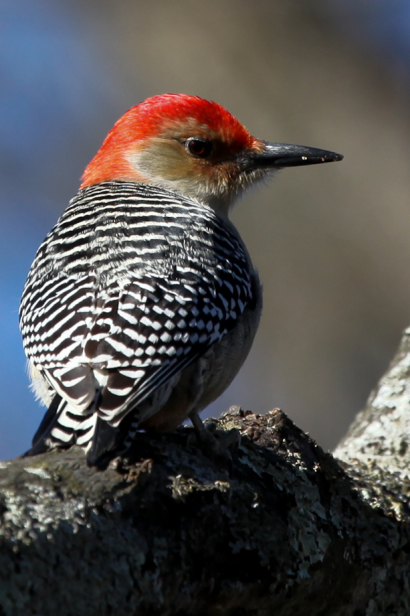Winter Backyard Birding
During wintertime, birds in Ohio change some of their habits. Some common summertime species, like chipping sparrows and ruby-throated hummingbirds, migrate to warmer climates. Other species, including Northern cardinals and red-bellied woodpeckers, remain in Ohio and simply adjust their routines. Like any good opportunist, most birds that hang around in the winter will also be on the lookout for a reliable source of food. This is where offering supplemental elements—food, water and shelter—can help our feathered friends survive the winter a little more comfortably.
Birds are warm-blooded critters, just like us. They are able to maintain their body temperature within a certain range, even when the air temperature changes. On cold, blustery days, birds fluff up their feathers creating air pockets, which help keep them warm. You might also see a bird perching on one leg, drawing the other leg towards its chest for warmth.
To help keep up their high metabolic rate in winter, birds consume rich, high-energy foods such as seeds, berries, insects found in cracks and crevices of buildings and suet (animal fat). There are times, however, when birds are not prepared to deal with sudden drops in temperature or sudden winter storms. At times like these, it is especially helpful to have feeders full so that birds can find food quickly and efficiently. While birds don’t become dependent on supplemental feeding from humans, you can certainly make their lives a little more comfortable.
Providing Food
Placement of the items you’re providing, whether it is food, water or shelter is very important. Feeders should be in an accessible location that’s easy for you to maintain properly and placed out of the wind. The east or southeast side of a house or near a row of trees is ideal. It is helpful to provide a good perching spot such as a shrub or tree for the birds to use. They can survey the feeding area and seek cover from predators like hawks or cats. The feeders should be positioned near cover but in the open to allow birds to watch for danger while feeding.
Placing seed in a ground feeder entices birds such as sparrows, juncos, mourning doves, towhees and brown thrashers. Platform and hopper feeders, which are elevated feeding systems, are especially good for attracting species such as cardinals, wrens, chickadees, titmice and blue jays.
Black oil sunflower is a great seed to offer in the winter. It is high in fat and protein and has a relatively thin shell, which makes less of a mess when discarded by the birds.
Suet, rendered animal fat filled with an assortment of treats like dried fruits, nuts and seeds, is a treasure-trove of calories and fat, which is invaluable for birds during frigid weather.
Providing Water
Sometimes people forget how important water is to wild critters during a drought or long freeze. Just like humans, many animals can go a few days without food. Water, however, is a necessity that wildlife cannot do without.
Bird baths are an excellent water source, but should be heated during the winter to prevent the whole bath from freezing in low temperatures. You can choose to put out a plastic dish with an added heater or a bird bath with a built-in heater. Don’t forget to keep it clean.
Providing Shelter
Roosting boxes or natural plant cover (such as trees, shrubs and bunchgrasses) can provide birds some relief from the elements and from predators. You can purchase pre-built boxes from many garden supply stores, but it is a lot more affordable and rewarding to make your own if you have the means.
Find free publications, nest box plans and ways to attract birds to your backyard at wildohio.gov/backyardbirding.
All photos courtesy of ODNR Division of Wildlife







